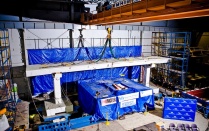SEAS students working towards more sustainable models for nuclear energy
By Elizabeth Egan
Published February 6, 2024
Sai Sharath Parsi and Kaivalya Lal, PhD students in the Department of Civil, Structural and Environmental Engineering, have been supporting a three-year project, funded by the Department of Energy, to develop a horizontal compact high temperature gas reactor (HC-HTGR) model.

Kaivalya Lal (Left) and Sai Sharath Parsi (right).
Traditional high temperature gas reactors are vertically oriented, and the reactor buildings are tall. The HC-HTGR model combines the reactor and steam generator into one integrated unit and rotates the primary axis of the building to horizontal, substantially reducing the height and volume of the building, and increasing its power density, measured as a function of kWe/volume.
The project is an interdisciplinary collaboration of civil/structural engineers, nuclear engineers, and mechanical engineers, led by the Massachusetts Institute of Technology, with partners at the University at Buffalo, Boston Atomics (a nuclear energy start-up based in Boston), the University at Michigan, Argonne National Laboratory, MPR Associates, and Simpson, Gumpertz and Heger. Andrew Whittaker, a SUNY Distinguished Professor in the Department of Civil, Structural and Environmental Engineering, is leading UB’s contribution to the project.
Other benefits of the HC-HTGR are reduced construction cost and simpler detailing and construction for earthquake resistance.

Earthquake-simulator experiment on representative graphite fuel-block assemblies to be part of the HC-HTGR core.
“Earthquakes are a critical hazard for the design of nuclear power plants,” said Parsi. “One focus of our work has been reducing the impact of the seismic load case on the capital cost of advanced reactors and the construction schedule. Reductions in building height translate to smaller seismic demands and more construction options. At UB we are working on the structural, mechanical and earthquake-engineering challenges posed to the building, selected equipment and fuel assemblies inside the reactor vessel.”
Lal noted that another focus of the project has been the implementation of seismic base isolation, a technology that has been advanced in civil, structural and environmental engineering for more than 30 years, with an objective of standardizing plant designs to be able to go to any site in the United States, regardless of the earthquake hazard.
Parsi said the project, which began in 2021, is on track to be finished by August 2024. “Once the conceptual work is completed, the team plans to move the HC-HTGR design forward on the path to commercialization in the early 2030s.”









